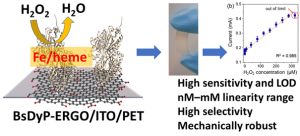Bacterial Peroxidase on Electrochemically Reduced Graphene Oxide for Highly Sensitive H2O2 Detection
Peroxidase enzymes enable the construction of electrochemical sensors for highly sensitive and selective quantitative detection of various molecules, pathogens and diseases. Herein, we describe the immobilization of a peroxidase from Bacillus s. (BsDyP) on electrochemically reduced graphene oxide (ERGO) deposited on indium tin oxide (ITO) and polyethylene terephthalate (PET) layers. XRD, SEM, AFM, FT-IR and Raman characterization of the sensor confirmed its structural integrity and a higher enzyme surface occupancy. The BsDyP-ERGO/ITO/PET electrode performed better than other horseradish peroxidase-based electrodes, as evinced by an improved electrochemical response in the nanomolar range (linearity 0.05–280 μM of H2O2, LOD 32 nM). The bioelectrode was mechanically robust, active in the 3.5–6 pH range and exhibited no loss of activity upon storage for 8 weeks at 4 °C.



